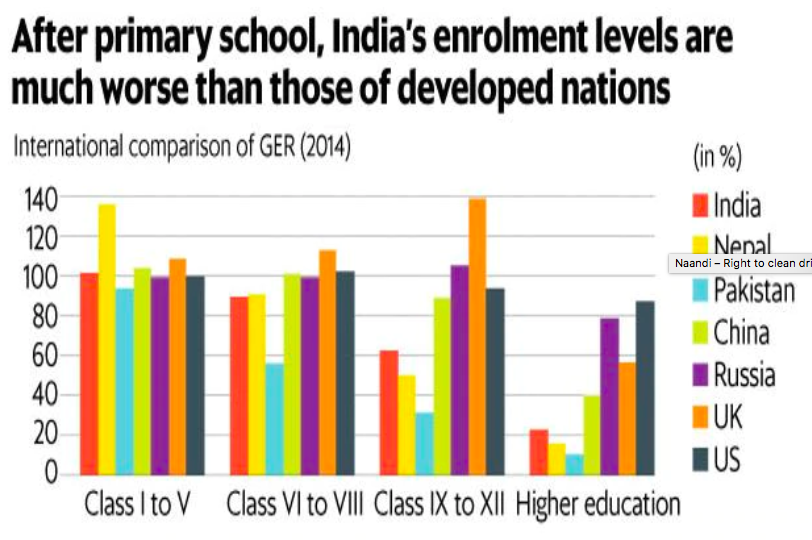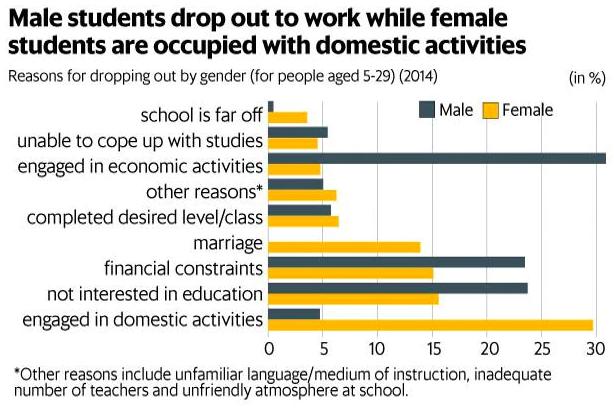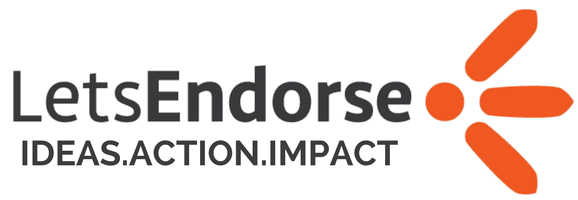A recent quote from Josh Bersin reads- “Companies that embrace diversity and inclusion in all aspects of their business statistically outperform their peers.”
And clearly, diversity alone doesn’t move the business forward—inclusion is an integral part. Let us take causal analysis to dig deeper into the first of the two challenges at hand, (i) we need to have more women join the workforce and (ii) we need to retain them, so they do not drop off.
We start with the assumption that more and more women will join the workforce if they have the necessary environment, encouragement, qualifications, and intent to do so. This is not an overnight process and we need to intervene at the school level to ensure that-
(i) Girls get enrolled in the school
(ii) Girls have access to basic infrastructure and learning aids to learn well
(iii) Girls are constantly encouraged to learn and perform well
(iv) Girls do not drop off owing to constraints and pressures
While universal enrolment has been achieved at the elementary level (class I-VIII), the enrolment consistently falls with successive levels of education. One or more of the aforementioned factors (ii), (iii) and (iv) play a role here. ![]()

The dropout rate peaks at the secondary level (class IX-X) at 17%. Under the RTE Act, a child cannot be expelled or detained until the completion of elementary education—i.e., until class VIII. This may explain the differential trends between the enrolment, dropout and transition rates for elementary education and secondary education.
The key reasons for female students dropping out are due to domestic activities, lack of interest in education and marriage. On the other hand, the key reasons for male students dropping out are economic activities, lack of interest in education and financial constraints.
 .
. 
From our experience of working with grassroots organizations and corporations, we observed how at several instances, provisioning basic and very fundamental infrastructure at school led to increasing enrollment and reducing drop-offs. Small changes, but if scaled up, can have a huge impact.
(i) 150 girls are now regularly attending Government High School, Somenahalli, all due to the spanking new, clean bio-toilet facility. Having no place to go and relieve themselves till about a year ago, the girls had to resort to use toilets of neighbors or hide in bushes or not attending school at all.
(ii) 110 girls who now feel more equipped to manage menstrual emergencies at the Shishu Mandir premise (and have not been missing classes), since we installed sanitary napkin vending machines and incinerators, right there in their washroom.
(ii) Salaam Bombay Foundation provides vocational training at school and ‘School Apprentice’ program with stipend linkage. While this prepares them for future sustainable careers, it also assures parents that the kids are going to school to learn a skill, which helps them earn as they learn.
(iv) A set of niche programs and volunteering initiatives which were centered around charting the career path have helped the girls understand the possible career paths. With more awareness and education about the next steps, more girls have made the conscious choices of studying further.
(v) A group of 200 girls who were anemic and missed classes often owing to dizziness and weakness, got tremendous help from the 12-cereal porridge mix prepared by women at an SHG run by Ashwini Charitable Trust. Well-nourished, these girls started showing symptoms of increased energy, concentration and thus attendance. Same is true for the Ashwagandhi churnam being in use at Chittoor.
(vi) A girl born with profound hearing loss in an impoverished family, who was assisted with cochlear implant surgery (supported by the Sethi Foundation’s FirstSound Program), now finds herself no different from a regular child. She attends classes regularly, is well-knitted into her support circle, is empowered for life and is marching her way to finishing her secondary examinations. From hopelessness to optimism, one should see how the outlook of her parents changed over the years.
We are sure that there must be hundreds of such examples where smaller interventions ended up creating a huge social return on investment and eventually transformed the lives of these girls. Isn’t this the right way of ensuring inclusion? By shifting the starting line of the race, where it should be.
Unless we start working for areas where the problems are stemming from, we might not be able to bring about a transformative wave when it comes to diversity and inclusion. In times to come, we foresee the D&I teams working hands-in-hands with the management and CSR teams of companies to ensure that the social investments cumulate to a multiplier effect.
We welcome the diverse thoughts and perspectives of practitioners in this field on this topic from their respective vantage points.
Sources: School Education in India: Flash Statistics, 2015-16, District Information System for Education; Key Indicators of Social Consumption in India: Education, NSS (71st Round); Education Statistics at a Glance, 2016, Ministry of Human Resource Development; PRS.


